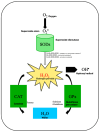Oxidative Stress Biomarkers in Male Infertility: Established Methodologies and Future Perspectives
- PMID: 38790168
- PMCID: PMC11121722
- DOI: 10.3390/genes15050539
Oxidative Stress Biomarkers in Male Infertility: Established Methodologies and Future Perspectives
Abstract
Male fertility can be affected by oxidative stress (OS), which occurs when an imbalance between the production of reactive oxygen species (ROS) and the body's ability to neutralize them arises. OS can damage cells and influence sperm production. High levels of lipid peroxidation have been linked to reduced sperm motility and decreased fertilization ability. This literature review discusses the most commonly used biomarkers to measure sperm damage caused by ROS, such as the high level of OS in seminal plasma as an indicator of imbalance in antioxidant activity. The investigated biomarkers include 8-hydroxy-2-deoxyguanosine acid (8-OHdG), a marker of DNA damage caused by ROS, and F2 isoprostanoids (8-isoprostanes) produced by lipid peroxidation. Furthermore, this review focuses on recent methodologies including the NGS polymorphisms and differentially expressed gene (DEG) analysis, as well as the epigenetic mechanisms linked to ROS during spermatogenesis along with new methodologies developed to evaluate OS biomarkers. Finally, this review addresses a valuable insight into the mechanisms of male infertility provided by these advances and how they have led to new treatment possibilities. Overall, the use of biomarkers to evaluate OS in male infertility has supplied innovative diagnostic and therapeutic approaches, enhancing our understanding of male infertility mechanisms.
Keywords: epigenetic alterations; infertility; omics; oxidative stress; sperm DNA damage.
Conflict of interest statement
The authors declare no conflicts of interest.
Figures



Similar articles
-
Increase of oxidative stress in human sperm with lower motility.Fertil Steril. 2008 May;89(5):1183-1190. doi: 10.1016/j.fertnstert.2007.05.029. Epub 2007 Jul 31. Fertil Steril. 2008. PMID: 17669405
-
Role of isoprostanes in human male infertility.Syst Biol Reprod Med. 2020 Oct;66(5):291-299. doi: 10.1080/19396368.2020.1793032. Epub 2020 Aug 25. Syst Biol Reprod Med. 2020. PMID: 32842780 Review.
-
In vivo oxidative stress alters thiol redox status of peroxiredoxin 1 and 6 and impairs rat sperm quality.Asian J Androl. 2017 Jan-Feb;19(1):73-79. doi: 10.4103/1008-682X.170863. Asian J Androl. 2017. PMID: 26823067 Free PMC article.
-
[Utility of oxidative stress test in the male infertility clinic].Zhonghua Nan Ke Xue. 2002;8(1):1-9. Zhonghua Nan Ke Xue. 2002. PMID: 12479038 Chinese.
-
Role of oxidative stress in male infertility.Reprod Fertil. 2023 Jul 7;4(3):e230024. doi: 10.1530/RAF-23-0024. Reprod Fertil. 2023. PMID: 37276172 Free PMC article. Review.
Cited by
-
Dietary and Lifestyle Interventions to Mitigate Oxidative Stress in Male and Female Fertility: Practical Insights for Infertility Management-A Narrative Review.Metabolites. 2025 Jun 8;15(6):379. doi: 10.3390/metabo15060379. Metabolites. 2025. PMID: 40559403 Free PMC article. Review.
-
Crosstalk Between Oxidative Stress and Epigenetics: Unveiling New Biomarkers in Human Infertility.Cells. 2024 Nov 7;13(22):1846. doi: 10.3390/cells13221846. Cells. 2024. PMID: 39594595 Free PMC article. Review.
-
Oxidative Stress-Associated Male Infertility: Current Diagnostic and Therapeutic Approaches.Medicina (Kaunas). 2024 Jun 20;60(6):1008. doi: 10.3390/medicina60061008. Medicina (Kaunas). 2024. PMID: 38929625 Free PMC article. Review.
-
Mechanisms of oxidative stress-induced sperm dysfunction.Front Endocrinol (Lausanne). 2025 Feb 5;16:1520835. doi: 10.3389/fendo.2025.1520835. eCollection 2025. Front Endocrinol (Lausanne). 2025. PMID: 39974821 Free PMC article. Review.
-
Total Round Cell Concentration in Semen and Its Association With Sperm DNA Fragmentation Index Among Ghanaian Males in Kumasi.Am J Mens Health. 2025 Jul-Aug;19(4):15579883251359420. doi: 10.1177/15579883251359420. Epub 2025 Jul 30. Am J Mens Health. 2025. PMID: 40737363 Free PMC article.
References
Publication types
MeSH terms
Substances
LinkOut - more resources
Full Text Sources
Medical
Miscellaneous

